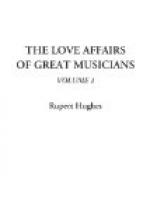Spitta speculates on the identity of this “stranger maiden.” In the older church-cantata women did not sing: in the newer form they occasionally did. She might have been a professional from the Brunswick opera. But Spitta decides that it must have been Maria Barbara Bach, his cousin from a neighbouring town. She is known to have had relatives and friends in Arnstadt, and Bach married her a year later. Assuming this to be true, Spitta notes that a delightful episode in the courtship of the young couple is disclosed to our view. Perhaps, too, when Bach “spoke to the parson,” he confessed his love and his betrothal.
Further Spitta comments: “The plan on which Bach wished to found his own family shows how he, too, was filled with that patriarchal feeling by which his race was distinguished and brought to such flourishing conditions. Without straying into foreign circles he found, in a relation who bore his name, the person whom he felt to be the most certain of understanding him. If we must call it a coincidence, it is, at any rate, a remarkable one, that Sebastian, in whom the gifts of his race reached their highest perfection, should also be the only one of its members to take a Bach to wife. If we are right in regarding the marriage union of individuals from families not allied in blood as the cause of a stronger growth of development in the children, Bach’s choice may signify that in him the highest summit of a development had been reached, so that his instinct disdained the natural way of attempting further improvement, and attracted him to his own race. His second wife, indeed, was not allied with him in blood, but that with the first he found, in some respects, his more natural development may perhaps be concluded from the fact that the most remarkable of his sons were all the children of his first marriage.”
Upton says that Bach loved Maria Barbara when he was only eighteen and they agreed to wait till he got a better post. This was not till three years had passed and then his salary was only eighty-five gulden (about L7, or $35) besides a little corn and wood and some kindling-wood.
It was on October 17, 1707, that, according to the record, “the respectable Herr J.S. Bach, the surviving lawful son of the late most respectable Herr Ambrosius Bach, the famous town-organist and musician of Eisenach, was married to the virtuous maiden Maria Barbara Bach, the youngest surviving unmarried daughter of the late very respectable and famous artist Herr Johann Michael Bach.”
A little inheritance of fifty gulden (L4 or $20) aided the new couple. But it is small wonder that we find Bach sighing later: “Modest as is my way of life, with the payment of house-rent and other indispensable articles of consumption, I can with difficulty live.” A year after his marriage, however, he was appointed court organist to the Grand Duke of Weimar, a post he held nine years. Then he became musical director with the Prince of Anhalt-Koethen.




